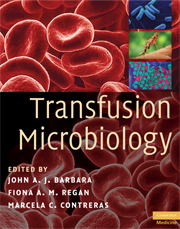Book contents
- Frontmatter
- Contents
- List of contributors
- Foreword
- Preface
- Acknowledgements
- Glossary
- Introduction: Transfusion-transmitted infections, then and now
- Section 1 Agents
- 1 Hepatitis viruses
- 2 Antibody to hepatitis B core antigen
- 3 Herpes viruses
- 4 Retroviruses
- 5 Parvovirus B19 (human erythroviruses)
- 6 Emerging viruses in transfusion
- 7 Bacterial contamination in blood and blood components
- 8 The protozoan parasites
- 9 Prion diseases
- Section 2 Selection and testing
- Section 3 Surveillance, risk and regulation
- Index
- Plate section
- References
4 - Retroviruses
from Section 1 - Agents
Published online by Cambridge University Press: 12 January 2010
- Frontmatter
- Contents
- List of contributors
- Foreword
- Preface
- Acknowledgements
- Glossary
- Introduction: Transfusion-transmitted infections, then and now
- Section 1 Agents
- 1 Hepatitis viruses
- 2 Antibody to hepatitis B core antigen
- 3 Herpes viruses
- 4 Retroviruses
- 5 Parvovirus B19 (human erythroviruses)
- 6 Emerging viruses in transfusion
- 7 Bacterial contamination in blood and blood components
- 8 The protozoan parasites
- 9 Prion diseases
- Section 2 Selection and testing
- Section 3 Surveillance, risk and regulation
- Index
- Plate section
- References
Summary
Retroviruses have a wide distribution in nature, with examples in insects, reptiles and nearly all mammals. The human retrovirus, human immunodeficiency virus (HIV 1 and 2), belongs to the lentivirus group of the retrovirus family, whilst human T-cell lymphotropic virus (HTLV I and II) belongs to the oncorna group. Human T-cell lymphotropic virus I and II are thought to have evolved from simian T-lymphotropic retroviruses that were transmitted to humans over the past centuries or millenia. Human immunodeficiency virus is thought to have derived from simian immunodeficiency viruses that are endemic in chimpanzees in Central Africa, and probably infected natives over the past century (Sharp et al., 2001).
Retroviruses are membrane-coated, single stranded RNA viruses that have a distinct genomic organization and require the presence of reverse transcriptase in their replication cycle. In a typical infection, retrovirus particles attach to the cell membrane, reverse transcriptase copies viral RNA into complementary double stranded DNA and this is integrated into the host cell chromosome. Host cell enzymes help virus and host regulatory genes complete the retrovirus lifecycle by producing virions that bud from the plasma membrane to infect other cells or organisms.
Human immunodeficiency viruses 1 and 2
Definition and characteristics of agent
Human immunodeficiency virus was discovered in the early 1980s by two groups of workers, Montagnier in France and Gallo in the USA. Originally described as human T cell lymphotropic virus type III (HTLV-III), the virus was shown to infect T-cell lymphocytes.
- Type
- Chapter
- Information
- Transfusion Microbiology , pp. 59 - 66Publisher: Cambridge University PressPrint publication year: 2008
References
- 1
- Cited by



